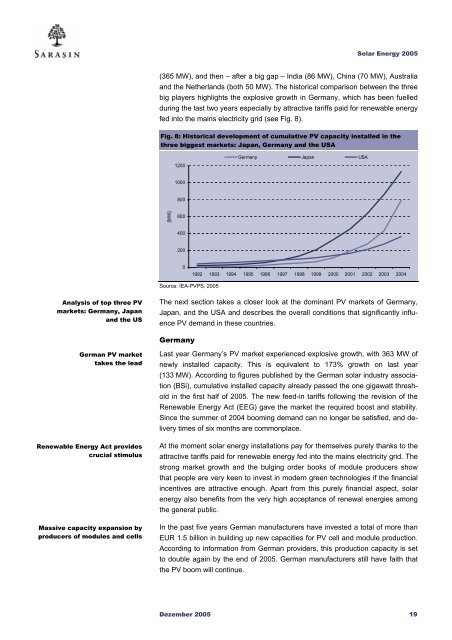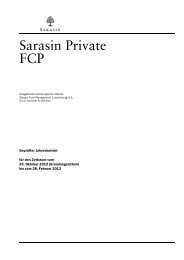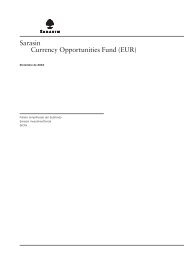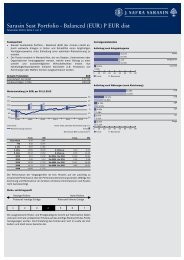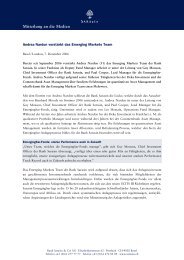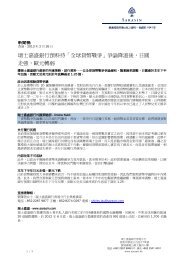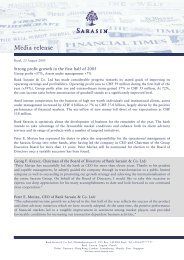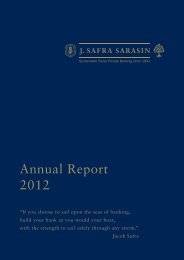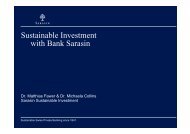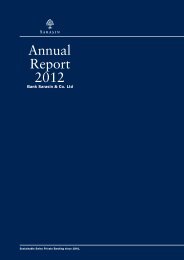Sustainability Report - Bank Sarasin-Alpen
Sustainability Report - Bank Sarasin-Alpen
Sustainability Report - Bank Sarasin-Alpen
You also want an ePaper? Increase the reach of your titles
YUMPU automatically turns print PDFs into web optimized ePapers that Google loves.
Solar Energy 2005<br />
(365 MW), and then – after a big gap – India (86 MW), China (70 MW), Australia<br />
and the Netherlands (both 50 MW). The historical comparison between the three<br />
big players highlights the explosive growth in Germany, which has been fuelled<br />
during the last two years especially by attractive tariffs paid for renewable energy<br />
fed into the mains electricity grid (see Fig. 8).<br />
Fig. 8: Historical development of cumulative PV capacity installed in the<br />
three biggest markets: Japan, Germany and the USA<br />
1200<br />
Germany Japan USA<br />
1000<br />
800<br />
[MW]<br />
600<br />
400<br />
200<br />
0<br />
1992 1993 1994 1995 1996 1997 1998 1999 2000 2001 2002 2003 2004<br />
Source: IEA-PVPS, 2005<br />
Analysis of top three PV<br />
markets: Germany, Japan<br />
and the US<br />
The next section takes a closer look at the dominant PV markets of Germany,<br />
Japan, and the USA and describes the overall conditions that significantly influence<br />
PV demand in these countries.<br />
Germany<br />
German PV market<br />
takes the lead<br />
Renewable Energy Act provides<br />
crucial stimulus<br />
Massive capacity expansion by<br />
producers of modules and cells<br />
Last year Germany’s PV market experienced explosive growth, with 363 MW of<br />
newly installed capacity. This is equivalent to 173% growth on last year<br />
(133 MW). According to figures published by the German solar industry association<br />
(BSi), cumulative installed capacity already passed the one gigawatt threshold<br />
in the first half of 2005. The new feed-in tariffs following the revision of the<br />
Renewable Energy Act (EEG) gave the market the required boost and stability.<br />
Since the summer of 2004 booming demand can no longer be satisfied, and delivery<br />
times of six months are commonplace.<br />
At the moment solar energy installations pay for themselves purely thanks to the<br />
attractive tariffs paid for renewable energy fed into the mains electricity grid. The<br />
strong market growth and the bulging order books of module producers show<br />
that people are very keen to invest in modern green technologies if the financial<br />
incentives are attractive enough. Apart from this purely financial aspect, solar<br />
energy also benefits from the very high acceptance of renewal energies among<br />
the general public.<br />
In the past five years German manufacturers have invested a total of more than<br />
EUR 1.5 billion in building up new capacities for PV cell and module production.<br />
According to information from German providers, this production capacity is set<br />
to double again by the end of 2005. German manufacturers still have faith that<br />
the PV boom will continue.<br />
Dezember 2005 19


